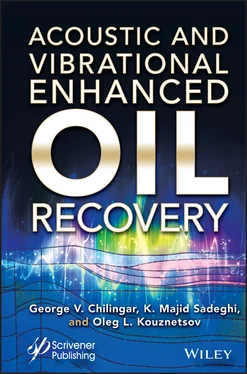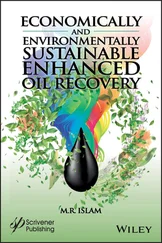1 Cover
2 Title Page
3 Copyright
4 Dedication
5 List of Contributors
6 1 Introduction 1.1 Origin and Migration of Oil 1.2 Seismic Vibration Techniques References and Bibliography
7 2 Wave Spreading Patterns in the Porous Media2.1 Spread of Vibration in Reservoir 2.2 Effect on the Wave Spread in the Oil Accumulations by the Geologic-Geophysical Conditions 2.3 Wave Spreading From the Vibrating Surface of the Reservoir Matrix Into the Saturated Medium 2.4 Excitation of Vibration in Oil Reservoirs References and Bibliography
8 3 Directional Displacement of a Dispersed Phase 3.1 Simplest Models of the Vibrational Directional Displacement 3.2 Physical Mechanisms and Major Types of Asymmetry Causing Vibratory Displacement 3.3 Directed Motion of the Dispersed Phase in Vibrating Pore Channels 3.4 Directional Motion of the Vibrating Dispersed Phase in Pore Channels References
9 4 Formation Damage Control and Cement Sheath Stability 4.1 Status of the Reservoir 4.2 Vibration Effect on the Reservoir’s Heat Properties 4.3 Decolmatation of the Near-Bottomhole Zone in the Vibration Field 4.4 Cement Sheath Stability Around a Well in the Vibration Field References and Bibliography
10 5 Effect of Vibration on Improving Oil Yield and Various Tertiary Recovery Technologies5.1 Major Causes of Incomplete Oil Recovery From the Subsurface 5.2 A Study of the Residual Formation Pressure in the Vibration Field 5.3 A Study of the Oil Capillary Displacement in the Vibration Field 5.4 Studies of the Oil and Water Gravity Flow in the Vibration Field References
11 6 Vibration Effect on Properties of Saturating Phases in a Reservoir6.1 Changes in Interfacial Tensions and Rheological Parameters 6.2 Permeability Changes 6.3 Capillary Pressure Changes 6.4 Interformational Oil Degassing and a Decline in the Formation Water Saturation References
12 7 Energy Criteria 7.1 Parameters of Oscillatory Treatment and Conditions for Manifestation of Useful Effects in Saturated Geological Media 7.2 Wavelike Nature of the Oil-Saturated Geological Media Stress-Energy Exchange. Elastic Oscillations as an Energy Exchange Indicator and Regulator 7.3 Justification of Rational Wave Treatment for the Near-Wellbore Zone and Entire Reservoir References and Bibliography
13 8 Types of Existing Treatments 8.1 Integrated Technologies of the Near-Wellbore Zone Vibrowave Treatment 8.2 Enhanced Oil Recovery Technologies Based on Vibroseismic Treatment (VST) References and Bibliography
14 9 Laboratory Experiments9.1 Laboratory Experiments 9.2 Displacement of Oil by Gas-Free Water in the Presence of Elastic Waves 9.3 Displacement of Oil by CO 2-Saturated Water in the Presence of Elastic Waves 9.4 Modeling of Oil Displacement by Water in Clayey Sandstones References and Bibliography
15 10 Oil Field Tests10.1 Abuzy Oil Field 10.2 Changirtash Oil Field 10.3 Jirnovskiy Oil Field, First Stage 10.4 Jirnovskiy Oil Field, Second Stage References and Bibliography
16 11 Electrokinetic Enhanced Oil Recovery (EEOR) 11.1 Introduction 11.2 Petroleum Reservoirs, Properties, Reserves, and Recoveries 11.3 Relative Permeability and Residual Saturation 11.4 Enhanced Oil Recovery 11.5 Electrokinetically Enhanced Oil Recovery 11.6 DCEOR (EEOR) and Energy Storage 11.7 Electrochemical Basis for DCEOR 11.8 DCEOR Field Operations 11.9 DCEOR Field Demonstrations 11.10 Produced Fluid Changes 11.11 Laboratory Measurements 11.12 Technology Comparisons 11.13 Summary 11.14 Nomenclature References
17 Addendum
18 Nomenclature
19 Symbols
20 About the Authors
21 Index
22 Also of Interest
23 End User License Agreement
1 Chapter 1 Figure 1.1 Decrease in the water cut in three wells after an earthquake: 1 = Mak... Figure 1.2 Schematic diagram of electrokinetic double layer (I: Immobile layer, ... Figure 1.3 Schematic diagram of EEOR (Electrical Enhanced Oil Recovery) electrod...
2 Chapter 2 Figure 2.1 Relative intensity of vibration fields E/E 0vs. reservoir thickness H... Figure 2.2 Distribution of relative vibration intensity  averaged over the rese... Figure 2.3 Vibration velocity distribution in a fracture (solid curves) and over... Figure 2.4 Vibration in a liquid volume at progressive vibrations of the fractur... Figure 2.5 Schematic advance of a mixture of a wetting and nonwetting liquids in... Figure 2.6 Velocity distribution in unconsolidated reservoir at transverse vibra...
averaged over the rese... Figure 2.3 Vibration velocity distribution in a fracture (solid curves) and over... Figure 2.4 Vibration in a liquid volume at progressive vibrations of the fractur... Figure 2.5 Schematic advance of a mixture of a wetting and nonwetting liquids in... Figure 2.6 Velocity distribution in unconsolidated reservoir at transverse vibra...
3 Chapter 3 Figure 3.1 Water flow in a cylindrical channel of some length L in the vibration... Figure 3.2 Movement of droplet of the horizontal non-uniform surface. (a) Pictur... Figure 3.3 Asymmetry types causing vibratory displacement. (a) As observed by ob... Figure 3.4 Particle motion within the vibrating medium with resistance. (a) Pict... Figure 3.5 Particle motion on an inclined flat surface in a harmonic vibration f... Figure 3.6 φ parameter vs. ω and R. Figure 3.7 Particle motion in a straight-linear cylindrical pore channel. (a) Pi... Figure 3.8 Schematic of emergence of vibratory lifting force. (a) As seen by obs... Figure 3.9 Effect of the vibrating pore channels’ configuration on the direction... Figure 3.10 Schematic directional fluid motion in vibrating pore channels. (a) A...Figure 3.11 Directional displacement of a vibrating kerosene droplet within a ca...
4 Chapter 4Figure 4.1 Effective heat conductivity for porous samples in a vibration field v...Figure 4.2 The temperature changes in the heat and vibration fields. 1. The heat...Figure 4.3 Injected hot water temperature vs. vibration power. 1, 2, and 3. Vibr...Figure 4.4 Gas hydrate decomposition in a vibration field. 1. Without vibration ...Figure 4.5 An installation scheme of measuring eigenpolarization potential of th...Figure 4.6 Permeability change in natural cores in the vibration field. 1. 11 kH...Figure 4.7 A nomogram for evaluation acceptable vibration pressure. a/b =: 1. −1...Figure 4.8 Amplitudes of maximum acceptable vibration pressures vs. the hardened...
5 Chapter 5Figure 5.1 Schematic of the lab installation for a study of the three-phase flow...Figure 5.2 The schematics of the lab installation for a study of three-phase flo...Figure 5.3 Oil displacement by water with various parameters in a vibration fiel...Figure 5.4 The displacement nature and variation of pressure gradient ΔP in the ...Figure 5.5 Oil by water (of various salinities) displacement from a clayey reser...Figure 5.6 Oil by mineralized water displacement from a clayey reservoir in a vi...Figure 5.7 Effect of water salinity on the oil recovery from a shaly reservoir i...Figure 5.8 The displacement at the flow of alkaline water in a shaly reservoir i...Figure 5.9 The displacement at the flow of mineralized water in a shaly reservoi...Figure 5.10 The oil displacement at the direct-flow capillary soaking of reservo...Figure 5.11 Direct-flow (curves 1 and 2) and counterflow (curves 3 and 4) natura...Figure 5.12 Pressure gradient change at capillary soaking with vibration. 1. No ...Figure 5.13 Capillary pression function (Leverett function) f(s) and relative ph...Figure 5.14 Gravity flow against the absolute permeability and function of absol...Figure 5.15 Relative phase permeability vs. gravity flow. 1. k n1(s), k w1(s); 2. ...Figure 5.16 Oil and water gravity flow in the vibration field.Figure 5.17 Scheme of movement of droplet in pore channel in the filed of vibrat...
6 Chapter 6Figure 6.1 Computed interrelations between the oil and water phase permeabilitie...Figure 6.2 Experimental values of phase permeabilities interrelation between the...Figure 6.3 Changes in the oil and water phase permeability ratio vs. water satur...Figure 6.4 Capillary pressure vs. water saturation based on results of gravity f...Figure 6.5 Water saturation change at the model oil displacement by distilled wa...Figure 6.6 Schematic acoustic pressure change at the formation pressure higher t...Figure 6.7 Schematic lab installation for a study of the effect of the intraform...Figure 6.8 Saturation pressure vs. time after the vibration stops. p 0is the sat...Figure 6.9 Heptane-propane mix saturation pressure vs. power of the vibration so...Figure 6.10 The gas bubble number in 1 cm 3at water de-gassing in vibration fiel...Figure 6.11 Increase in the oil-gas mix volume with the acoustic pressure increa...Figure 6.12 Formation water saturation change after the vibroseismic action in t...
Читать дальше

 averaged over the rese... Figure 2.3 Vibration velocity distribution in a fracture (solid curves) and over... Figure 2.4 Vibration in a liquid volume at progressive vibrations of the fractur... Figure 2.5 Schematic advance of a mixture of a wetting and nonwetting liquids in... Figure 2.6 Velocity distribution in unconsolidated reservoir at transverse vibra...
averaged over the rese... Figure 2.3 Vibration velocity distribution in a fracture (solid curves) and over... Figure 2.4 Vibration in a liquid volume at progressive vibrations of the fractur... Figure 2.5 Schematic advance of a mixture of a wetting and nonwetting liquids in... Figure 2.6 Velocity distribution in unconsolidated reservoir at transverse vibra...










